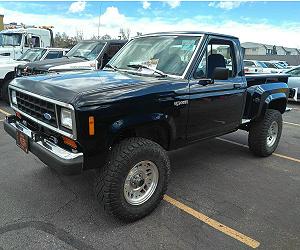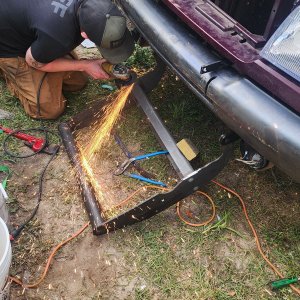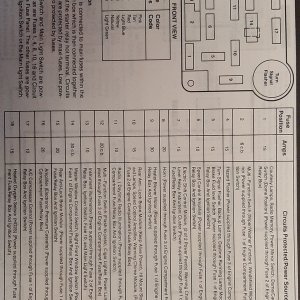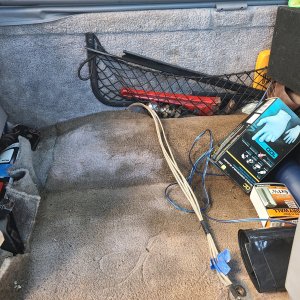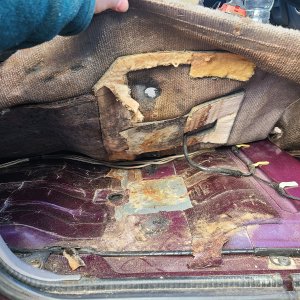97RangerXLT
Forum Staff Member
TRS Forum Moderator
Article Contributor
TRS 20th Anniversary
TRS Event Participant
- Joined
- Sep 18, 2007
- Messages
- 6,797
- Reaction score
- 3,941
- Points
- 113
- Location
- Fishers, IN
- Vehicle Year
- 1997
- Make / Model
- Ford
- Engine Type
- 4.0 V6
- Engine Size
- 4.0
- Transmission
- Automatic
- 2WD / 4WD
- 4WD
- Total Lift
- 2"
- Tire Size
- 31"
Ford 4.0 Valve cover gasket/intake gaskets (upper and lower)/fuel rail gasket and injector O-Ring replacement by 97RangerXLT
Tools needed:
7mm, 8mm, 10mm, 13mm sockets, flat blade ¼” screwdriver, 3” and 6” extension, torque wrench, large flat blade screwdriver or small prybar, small adjustable wrench, E7 reverse Torx socket (if you do the fuel rail gaskets)
Parts needed:
Valve cover gasket kit (I used Felpro Part Number: VS50368T from O’Reilly. This set comes with the lower fuel rail gasket) 33 bucks
Lower intake gasket. Get the one from Ford, not Felpro. Felpro uses cork on the ends, where Ford OEM uses rubber. Ford part number F7TZ-9E439-AA The price of the OEM Ford is only 6 bucks more than Felpro as well… 56 bucks. Ford had to order it special, but had it the next day.
Upper Intake O-Ring style gaskets. I used Felpro Part Number: MS90733 from O’Reilly. You will get 6, but only need three of them. Its only 5 bucks for the kit, so not a big deal.
Fuel injector O-rings. I used Felpro here. You will need 12 o-rings, they come in packages of 4. Part Number: ES70599 from O’Reilly, you will need three packages. 3 bucks each package
Thermostat (195*) Murray Part Number: 3199 from O’Reilly 5 bucks.
Optional parts or parts to consider while you are at it:
Upper radiator hose. Gates Part Number: 20823 O’Reilly 23 bucks.
Heater hose.
PCV valve hose.
Serpentine belt
Spark plugs
Spark plug wires
Difficulty level:
7 out of 10 wrenches. (lots of stuff to keep track of, and lots of connectors and vacuum lines to keep sorted out. You will also have to remove damn near everything from the top of the engine to do this repair. Plan on spending an entire afternoon to a whole day doing this job, and that is if you have all the parts you need on hand before you start.
Before job preparations:
Remove children, small animals, anyone with sensitive ears and anyone else that you do not want to be a target of your frustration and anger toward the Ford engineers that designed this cussing mess…
Disclaimer:
The Ranger Station.com, The Ranger Station.com Staff, nor the original poster are responsible for you doing this modification to your vehicle. By doing this modification and following this how-to you, the installer, take full responsibility if anything is damaged or messed up. If you have questions, feel free to PM the original poster or ask in the appropriate section of The Ranger Station.com forums.
To replace the valve cover gaskets, you will need to remove the upper intake manifold.
Remove upper intake: Please refer to pictures 4.0 pic 1.jpg, 4.0 pic 2.jpg, and 4.0 pic 5.jpg



1. Disconnect negative battery terminal. You don’t want to damage any sensors or the pcm.
2. Remove the rubber hose that connects the oil fill neck on the passenger side valve cover from the intake tube and valve cover. It should just pull off of both ends.
3. Disconnect the air charge temp sensor. Leave sensor in the intake tube.
4. Remove plastic throttle cable shield from throttle body. This is held on by 2 8mm screws.
5. Remove throttle cable/cruise cable assembly from throttle plate by snapping it off (it is held on by a ball connector)
6. Separate the throttle cable from the cruise cable. They are just snapped together. Tuck both of these aside and out of the way for now.
7. Remove intake tube from air filter and throttle body. It is secured by a large hose clamp on each end.
8. Remove the vacuum lines from the throttle body (goes to the evap and purge valve) egr valve, egr valve solenoid, and egr valve position sensor. Remember on the two vacuum lines to the egr valve position sensor, the vac line that is to the back of the egr tube goes to the nipple that is to the back of the sensor (handy way to remember which line goes where)
9. Disconnect the wiring harness from the egr valve solenoid, egr valve position sensor, MAF sensor, IAC valve and the A/C pressure sensor (if truck has A/C)
10. Disconnect brake booster vacuum line from the Upper Intake.
11. Remove vacuum line that goes to the egr valve solenoid from the Upper Intake
12. Remove PCV valve hose from upper intake and PCV valve.
13. Disconnect the upper engine harness. This is done by a single 10mm bolt in the middle of the connector.
14. Slide the bottom half of the harness off of the metal rail.
15. Unhook the spark plug wires from the coil pack. Be sure to note the coil pack order as you are looking at it from the passenger side firewall to front bumper: 3-2-1(passenger side of the coil) and 4-6-5(drivers side of the coil). If you get this order messed up, your truck will run like crap. (if it runs at all…)trust me…
16. Disconnect wire harness from coil pack.
17. Remove coil pack from Upper intake. (four 8mm bolts)
18. Congratulations! You now have enough of the crap removed so that you can actually remove the cussing upper intake!
19. Take some time now to use the air hose (if you are so lucky to have an aircompressor in your garage) and blow the debris out of the intake area before you go further. If you don’t have shop air, get a can of air and blow it out. This should help with stuff falling into the engine.
20. Grab a ratchet, 6” extension and a 13mm socket and remove the 6 nuts holding the upper intake.
21. Give the intake a smack with the heel of your hand to break the seal of the gaskets. Lift and pry (gently) straight up. You will have to work with the egr tube. It sticks into the intake about 2-3 inches. Keep working and prying and you will eventually free the intake assembly.
22. Replace the three o-ring type gaskets in the bottom of the upper intake. Set the intake assembly aside for now.
23. Congratulations, you are now done with removing the upper intake.
24. When putting the upper intake back on, torque to these specifications:
<Firewall 4 2 6
5 3 1
To 20-25 N*m (15-18 lb*ft)
Now for the Valve covers. Please refer to pictures 4.0 pic 3.jpg, 4.0 pic 4.jpg, and 4.0 pic 6.jpg



1. Unhook the alternator wiring harness and the charging wire (held on by a 10mm nut)
2. Take a 3/8” ratchet and take the tension off of the serpentine belt enough so that you can remove the belt.
3. Remove the alternator. It is held on by three 13mm bolts.
4. Drain the radiator. (now’s a good time as any to change the coolant…)
5. Remove the upper radiator hose.
6. Remove the heater hose from the lower intake.
7. Unbolt the A/C compressor (if so equipped). You do not have to discharge the Freon. Just remove the four long 13mm bolts and swing the compressor to the side about 8 inches or so that it is out of the way.
8. Disconnect the wiring harness from the fuel injectors and the temperature sensor in the lower intake.
9. The wiring harness is held to the front drivers side valve cover and the rear passenger side valve cover by a plastic clip that goes over a 4mm stud that is one of the bolts to the valve cover. With a little wiggling and working, remove this clip from that stud on each valve cover.
10. You now should have all the bolts to the valve covers exposed. Remove them with a 10mm socket and 3” extension. Some bolts may need a universal joint to make extraction easier. There are 8 bolts per valve cover, with one of them being the 4mm stud/bolt combo on each side.
11. The passenger side valve cover should come out with minimal fuss.
12. The driver’s side valve cover will fuss quite abit. The biggest part of the fuss will be the egr tube.
13. You can remove the tube (after looking at the rust involved and the aggravation, I decided to go another route)
14. Take your 6” extension and stick it down the egr tube. Take a 3” extension and stick in the 6” extension. Use this assembly to gently pull the egr tube toward you (leaning over the drivers fender) as you wiggle the valve cover out.
15. Be sure to clean all the gasket surfaces on the head and intake very well and be careful not to let any debris fall into the engine.
16. Now is a good time to paint up your valve covers. Mine were rusted through, so I ended up replacing them with a set from the junkyard off of a 98 explorer. I painted mine up Ford blue. They really look sharp compared to the original grey.
17. Be sure that you put the valve cover gasket down in the correct position. Put some heat resistant RTV silicone in the area where the heads meet the intake on both sides of the gasket.
18. Decision time. You have invested a few hours and more than a few swear words at this truck by now. Do you want to go a few steps further and replace the lower intake gasket? Or do the fuel rail gaskets? If so, read on. If not, start slapping it back together. Remember, if you do need to do the lower gasket in the future, you have to repeat all of the above. If you do the fuel rail gaskets in the future, you have to at least remove the upper intake again. If you have a 1997 Ranger/exploder/aerostar, there is an issue (and a TSB) for the fuel rail gasket. It seems to go bad and cause a P0174 and P0171 lean code. I would go ahead and do the fuel rail gasket at the very least. It will only add about 15 bucks to your cost and very little extra labor. The lower gasket set will cost you about 56 bucks more, but will be worth it in terms of tearing down the upper engine again. If you do go this route, go to the Stealership and get the Ford lower gasket. It is better. And it cost me only a few bucks more than it would if I got it at AutoZone/O’Rielly. The Ford set has all rubber seals, where the AutoZone/O’Reilly Felpro set has cork. My local Ford dealer had to order it, but had it there the next day. (ordered on lunch hour Thursday, and picked it up on lunch hour on Friday.)
So you decided that you need more abuse and are going to do the lower intake and fuel rail gaskets! Well here you go:
I went and removed the lower intake/fuel rail as a unit and did the fuel rail gaskets on the workbench out of the truck. Made it much easier to clean the gasket surfaces and injector o-ring areas.
Lower intake gasket: Please refer to pictures 4.0 pic 5.jpg, 4.0 pic 7.jpg, 4.0 pic 8.jpg, and 4.0 pic 9.jpg




1. Remove thermostat housing. It is held on by three 10mm bolts. Note the position and orientation of the thermostat.
2. Pitch the old thermostat.
3. Disconnect vacuum line from fuel pressure regulator.
4. Remove fuel line and fuel return line from fuel rail. Use adjustable wrench. They are two different size nuts. Be careful, the fuel rail will be pressurized. Put a shop towel around the first nut you loosen to catch the spray of fuel.
5. Remove the eight 10mm bolts holding the lower intake in.
6. Remove intake assembly.
7. Remove lower intake gasket and thoroughly clean gasket mating surfaces in the engine and on the lower intake. Be careful not to get any debris in the engine.
8. IF you are doing the fuel rail gaskets, do so now (see below).
9. Put new lower intake gasket set in. put RTV silicone in the areas where the heads meet the engine block on both sides of the gasket. This will help with any imperfections in the surfaces where these parts join.
10. Set the lower intake assembly in and put the 8 bolts back in. torque them in this sequence:
<Firewall 3 5 7 2
1 6 8 4
First tighten down to 2.5 N*m (22lb *in)
Second tighten to 10 N*m (88lb * in)
Third tighten to 13 N*m (115 lb* in)
Finally, tighten to 14-18 N*m (11-13 lb *ft)
11. Put a new 195 degree thermostat with the jiggle valve in the up position into the intake and put the thermostat housing back on.
12. Start reassembling the truck.
If you need to replace the fuel rail gaskets: Refer to picture 4.0 pic 10.jpg

1. Remove the six reverse torx bolts from the fuel rail using an E7 star socket. You may notice that the paper fuel rail gasket is starting to or maybe already has broken between the intake ports. This will cause a lean code condition. (P0171 and P0174)
2. Gently pry the fuel rail off of the lower intake and the six injectors. Note the orientation of the injectors beforehand.
3. Remove all six injectors and discard all 12 o-rings.
4. Thoroughly clean all gasket surfaces and o-ring surfaces.
5. Clean the o-ring areas on all the injectors.
6. Put new o-rings on the injectors. A light film of motor oil on the o-rings will help in seating the injectors.
7. Put the injectors into the lower intake.
8. Put new paper gasket between the fuel rail and lower intake and make sure all of the injectors are seated into the fuel rail.
9. Put the six reverse torx bolts back in and torque them down in this sequence:
<Firewall 1 3 5
6 4 2
To 12-16 N*m (9-11 lb*ft)
reassembly is the reverse of the dissassembly. after you get this done, get you a cold one. heck get two. you deserve it.
(you can let the children and small animals back in the area now)
AJ
Tools needed:
7mm, 8mm, 10mm, 13mm sockets, flat blade ¼” screwdriver, 3” and 6” extension, torque wrench, large flat blade screwdriver or small prybar, small adjustable wrench, E7 reverse Torx socket (if you do the fuel rail gaskets)
Parts needed:
Valve cover gasket kit (I used Felpro Part Number: VS50368T from O’Reilly. This set comes with the lower fuel rail gasket) 33 bucks
Lower intake gasket. Get the one from Ford, not Felpro. Felpro uses cork on the ends, where Ford OEM uses rubber. Ford part number F7TZ-9E439-AA The price of the OEM Ford is only 6 bucks more than Felpro as well… 56 bucks. Ford had to order it special, but had it the next day.
Upper Intake O-Ring style gaskets. I used Felpro Part Number: MS90733 from O’Reilly. You will get 6, but only need three of them. Its only 5 bucks for the kit, so not a big deal.
Fuel injector O-rings. I used Felpro here. You will need 12 o-rings, they come in packages of 4. Part Number: ES70599 from O’Reilly, you will need three packages. 3 bucks each package
Thermostat (195*) Murray Part Number: 3199 from O’Reilly 5 bucks.
Optional parts or parts to consider while you are at it:
Upper radiator hose. Gates Part Number: 20823 O’Reilly 23 bucks.
Heater hose.
PCV valve hose.
Serpentine belt
Spark plugs
Spark plug wires
Difficulty level:
7 out of 10 wrenches. (lots of stuff to keep track of, and lots of connectors and vacuum lines to keep sorted out. You will also have to remove damn near everything from the top of the engine to do this repair. Plan on spending an entire afternoon to a whole day doing this job, and that is if you have all the parts you need on hand before you start.
Before job preparations:
Remove children, small animals, anyone with sensitive ears and anyone else that you do not want to be a target of your frustration and anger toward the Ford engineers that designed this cussing mess…
Disclaimer:
The Ranger Station.com, The Ranger Station.com Staff, nor the original poster are responsible for you doing this modification to your vehicle. By doing this modification and following this how-to you, the installer, take full responsibility if anything is damaged or messed up. If you have questions, feel free to PM the original poster or ask in the appropriate section of The Ranger Station.com forums.
To replace the valve cover gaskets, you will need to remove the upper intake manifold.
Remove upper intake: Please refer to pictures 4.0 pic 1.jpg, 4.0 pic 2.jpg, and 4.0 pic 5.jpg



1. Disconnect negative battery terminal. You don’t want to damage any sensors or the pcm.
2. Remove the rubber hose that connects the oil fill neck on the passenger side valve cover from the intake tube and valve cover. It should just pull off of both ends.
3. Disconnect the air charge temp sensor. Leave sensor in the intake tube.
4. Remove plastic throttle cable shield from throttle body. This is held on by 2 8mm screws.
5. Remove throttle cable/cruise cable assembly from throttle plate by snapping it off (it is held on by a ball connector)
6. Separate the throttle cable from the cruise cable. They are just snapped together. Tuck both of these aside and out of the way for now.
7. Remove intake tube from air filter and throttle body. It is secured by a large hose clamp on each end.
8. Remove the vacuum lines from the throttle body (goes to the evap and purge valve) egr valve, egr valve solenoid, and egr valve position sensor. Remember on the two vacuum lines to the egr valve position sensor, the vac line that is to the back of the egr tube goes to the nipple that is to the back of the sensor (handy way to remember which line goes where)
9. Disconnect the wiring harness from the egr valve solenoid, egr valve position sensor, MAF sensor, IAC valve and the A/C pressure sensor (if truck has A/C)
10. Disconnect brake booster vacuum line from the Upper Intake.
11. Remove vacuum line that goes to the egr valve solenoid from the Upper Intake
12. Remove PCV valve hose from upper intake and PCV valve.
13. Disconnect the upper engine harness. This is done by a single 10mm bolt in the middle of the connector.
14. Slide the bottom half of the harness off of the metal rail.
15. Unhook the spark plug wires from the coil pack. Be sure to note the coil pack order as you are looking at it from the passenger side firewall to front bumper: 3-2-1(passenger side of the coil) and 4-6-5(drivers side of the coil). If you get this order messed up, your truck will run like crap. (if it runs at all…)trust me…
16. Disconnect wire harness from coil pack.
17. Remove coil pack from Upper intake. (four 8mm bolts)
18. Congratulations! You now have enough of the crap removed so that you can actually remove the cussing upper intake!
19. Take some time now to use the air hose (if you are so lucky to have an aircompressor in your garage) and blow the debris out of the intake area before you go further. If you don’t have shop air, get a can of air and blow it out. This should help with stuff falling into the engine.
20. Grab a ratchet, 6” extension and a 13mm socket and remove the 6 nuts holding the upper intake.
21. Give the intake a smack with the heel of your hand to break the seal of the gaskets. Lift and pry (gently) straight up. You will have to work with the egr tube. It sticks into the intake about 2-3 inches. Keep working and prying and you will eventually free the intake assembly.
22. Replace the three o-ring type gaskets in the bottom of the upper intake. Set the intake assembly aside for now.
23. Congratulations, you are now done with removing the upper intake.
24. When putting the upper intake back on, torque to these specifications:
<Firewall 4 2 6
5 3 1
To 20-25 N*m (15-18 lb*ft)
Now for the Valve covers. Please refer to pictures 4.0 pic 3.jpg, 4.0 pic 4.jpg, and 4.0 pic 6.jpg



1. Unhook the alternator wiring harness and the charging wire (held on by a 10mm nut)
2. Take a 3/8” ratchet and take the tension off of the serpentine belt enough so that you can remove the belt.
3. Remove the alternator. It is held on by three 13mm bolts.
4. Drain the radiator. (now’s a good time as any to change the coolant…)
5. Remove the upper radiator hose.
6. Remove the heater hose from the lower intake.
7. Unbolt the A/C compressor (if so equipped). You do not have to discharge the Freon. Just remove the four long 13mm bolts and swing the compressor to the side about 8 inches or so that it is out of the way.
8. Disconnect the wiring harness from the fuel injectors and the temperature sensor in the lower intake.
9. The wiring harness is held to the front drivers side valve cover and the rear passenger side valve cover by a plastic clip that goes over a 4mm stud that is one of the bolts to the valve cover. With a little wiggling and working, remove this clip from that stud on each valve cover.
10. You now should have all the bolts to the valve covers exposed. Remove them with a 10mm socket and 3” extension. Some bolts may need a universal joint to make extraction easier. There are 8 bolts per valve cover, with one of them being the 4mm stud/bolt combo on each side.
11. The passenger side valve cover should come out with minimal fuss.
12. The driver’s side valve cover will fuss quite abit. The biggest part of the fuss will be the egr tube.
13. You can remove the tube (after looking at the rust involved and the aggravation, I decided to go another route)
14. Take your 6” extension and stick it down the egr tube. Take a 3” extension and stick in the 6” extension. Use this assembly to gently pull the egr tube toward you (leaning over the drivers fender) as you wiggle the valve cover out.
15. Be sure to clean all the gasket surfaces on the head and intake very well and be careful not to let any debris fall into the engine.
16. Now is a good time to paint up your valve covers. Mine were rusted through, so I ended up replacing them with a set from the junkyard off of a 98 explorer. I painted mine up Ford blue. They really look sharp compared to the original grey.
17. Be sure that you put the valve cover gasket down in the correct position. Put some heat resistant RTV silicone in the area where the heads meet the intake on both sides of the gasket.
18. Decision time. You have invested a few hours and more than a few swear words at this truck by now. Do you want to go a few steps further and replace the lower intake gasket? Or do the fuel rail gaskets? If so, read on. If not, start slapping it back together. Remember, if you do need to do the lower gasket in the future, you have to repeat all of the above. If you do the fuel rail gaskets in the future, you have to at least remove the upper intake again. If you have a 1997 Ranger/exploder/aerostar, there is an issue (and a TSB) for the fuel rail gasket. It seems to go bad and cause a P0174 and P0171 lean code. I would go ahead and do the fuel rail gasket at the very least. It will only add about 15 bucks to your cost and very little extra labor. The lower gasket set will cost you about 56 bucks more, but will be worth it in terms of tearing down the upper engine again. If you do go this route, go to the Stealership and get the Ford lower gasket. It is better. And it cost me only a few bucks more than it would if I got it at AutoZone/O’Rielly. The Ford set has all rubber seals, where the AutoZone/O’Reilly Felpro set has cork. My local Ford dealer had to order it, but had it there the next day. (ordered on lunch hour Thursday, and picked it up on lunch hour on Friday.)
So you decided that you need more abuse and are going to do the lower intake and fuel rail gaskets! Well here you go:
I went and removed the lower intake/fuel rail as a unit and did the fuel rail gaskets on the workbench out of the truck. Made it much easier to clean the gasket surfaces and injector o-ring areas.
Lower intake gasket: Please refer to pictures 4.0 pic 5.jpg, 4.0 pic 7.jpg, 4.0 pic 8.jpg, and 4.0 pic 9.jpg




1. Remove thermostat housing. It is held on by three 10mm bolts. Note the position and orientation of the thermostat.
2. Pitch the old thermostat.
3. Disconnect vacuum line from fuel pressure regulator.
4. Remove fuel line and fuel return line from fuel rail. Use adjustable wrench. They are two different size nuts. Be careful, the fuel rail will be pressurized. Put a shop towel around the first nut you loosen to catch the spray of fuel.
5. Remove the eight 10mm bolts holding the lower intake in.
6. Remove intake assembly.
7. Remove lower intake gasket and thoroughly clean gasket mating surfaces in the engine and on the lower intake. Be careful not to get any debris in the engine.
8. IF you are doing the fuel rail gaskets, do so now (see below).
9. Put new lower intake gasket set in. put RTV silicone in the areas where the heads meet the engine block on both sides of the gasket. This will help with any imperfections in the surfaces where these parts join.
10. Set the lower intake assembly in and put the 8 bolts back in. torque them in this sequence:
<Firewall 3 5 7 2
1 6 8 4
First tighten down to 2.5 N*m (22lb *in)
Second tighten to 10 N*m (88lb * in)
Third tighten to 13 N*m (115 lb* in)
Finally, tighten to 14-18 N*m (11-13 lb *ft)
11. Put a new 195 degree thermostat with the jiggle valve in the up position into the intake and put the thermostat housing back on.
12. Start reassembling the truck.
If you need to replace the fuel rail gaskets: Refer to picture 4.0 pic 10.jpg

1. Remove the six reverse torx bolts from the fuel rail using an E7 star socket. You may notice that the paper fuel rail gasket is starting to or maybe already has broken between the intake ports. This will cause a lean code condition. (P0171 and P0174)
2. Gently pry the fuel rail off of the lower intake and the six injectors. Note the orientation of the injectors beforehand.
3. Remove all six injectors and discard all 12 o-rings.
4. Thoroughly clean all gasket surfaces and o-ring surfaces.
5. Clean the o-ring areas on all the injectors.
6. Put new o-rings on the injectors. A light film of motor oil on the o-rings will help in seating the injectors.
7. Put the injectors into the lower intake.
8. Put new paper gasket between the fuel rail and lower intake and make sure all of the injectors are seated into the fuel rail.
9. Put the six reverse torx bolts back in and torque them down in this sequence:
<Firewall 1 3 5
6 4 2
To 12-16 N*m (9-11 lb*ft)
reassembly is the reverse of the dissassembly. after you get this done, get you a cold one. heck get two. you deserve it.
(you can let the children and small animals back in the area now)
AJ







